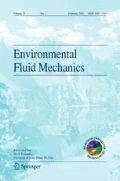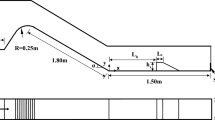Abstract
Due to the lack of data on hydraulic-jump dynamics in very large channels, the present paper describes the main characteristics of the velocity field and turbulence in a large rectangular channel with a width of 4 m. Although a hydraulic jump is always treated as a wave that is transversal to the channel wall, in the case of this study it has a trapezoidal front shape, first starting from a point at the sidewalls and then developing downstream in an oblique manner, finally giving rise to a trapezoidal shape. The oblique wave front may be regarded as a lateral shockwave that arises from a perturbation at a certain point of the lateral wall and travels obliquely toward the centreline of the channel. The experimental work was carried out at the Coastal Engineering Laboratory of the Water Engineering and Chemistry Department of the Technical University of Bari (Italy). In addition to the hydraulic jump formation, a large recirculating flow zone starts to develop from the separating point of the lateral shock wave and a separate boundary layer occurs. Intensive measurements of the streamwise and spanwise flow velocity components along one-half width of the channel were taken using a bidimensional Acoustic Doppler Velocimeter (ADV). The water surface elevation was obtained by means of an ultrasonic profiler. Velocity vectors, transversal velocity profiles, turbulence intensities and Reynolds shear stresses were all investigated. The experimental results of the separated boundary layer were compared with numerical predictions and related work presented in literature and showed good agreement. The transversal velocity profiles indicated the presence of adverse pressure gradient zones and the law of the wall appears to govern the region around the separated boundary layer.
Similar content being viewed by others
Abbreviations
- β :
-
Angle between the lateral shockwave and the channel side wall (°)
- λ :
-
Minimum distance from the upstream gate in order to have flow development (m)
- ν :
-
Water kinematic viscosity (m2 s−1)
- ψ :
-
Streamline function (m2s−1)
- κ :
-
Von Karman’s constant (–)
- \({\Phi}\) :
-
Parameter of the velocity logarithmic law (–)
- δ * :
-
Displacement thickness of the lateral boundary layer (m)
- A, B:
-
Parameters of Eq. 3 (ms−1)
- AR:
-
Jump aspect ratio=B/h0 (–)
- B:
-
Channel width (m)
- bj:
-
Length of the hydraulic jump front normal to the upstream current (m)
- F0 :
-
Froude number at the vena contracta (–)
- h0 :
-
Flow depth at the vena contracta (m)
- hg :
-
Opening of sluice gate (m)
- ks :
-
Representative roughness height (m)
- L:
-
Longitudinal length from the upstream channel gate to the hydraulic jump front normal to the upstream current (m)
- l:
-
Longitudinal distance from the upstream channel gate to the toe of the shockwave (m)
- Q:
-
Flow discharge (m3s−1)
- Re:
-
=Q/(Bν)=Channel flow Reynolds number (–)
- Rex :
-
=Ucx/ν=local Reynolds number (–)
- U:
-
Time-averaged streamwise (longitudinal) velocity (ms−1)
- U*:
-
Friction velocity (ms−1)
- u′, v′:
-
r.m.s of the longitudinal and transversal turbulent velocity components, respectively, i.s. longitudinal and transversal turbulent intensities (ms−1)
- \({\overline{u^{\prime}v^{\prime}}}\) :
-
Crosscorrelation of the turbulent streamwise and wall normal velocity components, i.e. Reynolds shear stress apart from the water density (m2s−2)
- U+ :
-
=U/U*=Dimensionless time-averaged streamwise velocity (–)
- U0 :
-
Channel flow velocity at the vena contracta (ms−1)
- Uc :
-
Channel flow velocity at a distance equal to l/2 from the upstream gate (ms−1)
- V:
-
Time-averaged wall-normal velocity, positive if oriented toward the channel right wall (ms−1)
- V :
-
Time-averaged horizontal velocity vector (ms−1)
- x:
-
Longitudinal coordinates from the upstream channel gate (m)
- y:
-
Distance from the wall (m)
- Y:
-
Distance transversal to the channel, starting from the separated boundary layer ψ = 0, i.e. Y=0 is where ψ = 0 (m)
- Y+ :
-
=YU*/ν=dimensionless Y distance (–)
- Y0 :
-
Distance normal to the channel side wall from the separated boundary layer where ψ = 0 to the channel longitudinal axis where y = 2m (m)
References
Babarutsi S, Nassiri M, Chu VH (1996) Computation of shallow recirculating flow dominated by friction. J Hydraul Eng 122(7): 367–372
Badran OO, Bruun HH (1998) The effect of inlet conditions on flow over backward facing step. J Wind Eng Indus Aerodyn 74–76: 495–509
Ben Meftah M, De Serio F, Mossa M, Pollio A (2007) Experimental observations on undular hydraulic jumps with very high aspect ratio. 32nd Congress of IAHR, International association of hydraulic engineering and research, July 1–6, 2007 Venice, Italy, pp 581
Ben Meftah M, De Serio F, Mossa M, Pollio A (2007) Analysis of the velocity field in a large rectangular channel with lateral shockwave. Environ Fluid Mech 7(6): 519–536
Blinco PH, Partheniades E (1971) Turbulence characteristics in free surface flows over smooth and rough boundaries. J Hydraul Res 9(1): 43–71
Carling PA (1995) Flow-separation berms downstream of a hydraulic jump in a bedrock channel. Geomorphology 11: 245–253
Chanson H, Montes JS (1995) Characteristics of undular hydraulic jump: Experimental apparatus and flow patterns. J Hydraul Eng 121(2): 129–144
Chow VT (1959) Open channel hydraulics. McGraw-Hill Book Company, New York
Gullman-Strand J, Tornblom O, Lindgren B, Amberg G, Johansson AV (2004) Numerical and experimental study of separated flow in a plane asymmetric diffuser. Int J Heat Fluid Flow 25: 451–460
Henderson FM (1966) Open channel flow. Macmillan, New York
Henry HR (1950) Discussion of ‘diffusion of submerged jets,’ by Albertson ML, Dai YB, Jensen RA, Rouse H. Trans Am Soc Civ Eng 115:687–694
Ippen AT (1951) Mechanics of supercritical flow. Trans ASCE 116: 268–295
Kironoto BA, Graf WH (1995) Turbulence characteristics in rough non-uniform open-channel flows. Publ of Inst Civ Engrs Wat Marit Ener 112(12): 336–348
Laufer J (1950) Investigation of turbulent flow in a two-dimensional channel. NACA, Report 1053, pp 1247–1266
Leutheusser HJ, Alemu S (1979) Flow separation under hydraulic jump. J Hydraul Res 17(3): 193–206
Mossa M (1999) On the oscillating characteristics of hydraulic jump. J Hydraul Res 37(4): 541–558
Mossa M, Tolve U (1998) Flow visualization in bubbly two-phase hydraulic jump. J Fluid Eng Trans ASME 120(1)
Na Y, Moin P (1998) Direct numerical simulation of a separated turbulent boundary layer. J Fluid Mech 374: 379–405
Nezu I, Nakagawa W (1993) Turbulence in open-channel flow. IAHR Monograph Series, Balkema Rotterdam
Nezu I, Rodi W (1986) Open-channel flow measurement with a laser Doppler anemometer. J Hydraul Eng ASCE 112: 335–355
Ohtsu I, Yasuda Y, Gotoh H (1995) Characteristics of undular jump in rectangular channels. Proceedings of XXVI international association for hydraulic research congress, London, 1C14, pp 450–455
Ohtsu I, Yasuda Y, Gotoh H (2001) Hydraulic condition for undular-jump formations. J Hydraul Res 39(2): 203–209
Ohtsu I, Yasuda Y, Gotoh H (2003) Flow conditions of undular hydraulic jumps in horizontal rectangular channels. J Hydraul Eng 129(12): 948–955
Perry AE, Fairlie BD (1975) A study of turbulent boundary-layer separation and reattachments. J Fluid Mech 69: 657–672
Rajaratnam N, Subramanya K (1967) Flow equation for the sluice gate. J Irrig Drain Eng 93(3): 167–186
Reinauer R, Hager WH (1995) Non-breaking undular hydraulic jumps. J Hydraul Res 33(5): 1–16
Rouse H, Bhoota BV, Hsu E-Y (1951) Design of channel expansions. Trans ASCE 116: 347–363
Schlichting H (1979) Boundary Layer theory, 7th edn. McGraw-Hill, New York
Shiloh K, Shivaprasad BG, Simpson RL (1981) The structure of a separating turbulent layer Part 3 Transverse velocity measurements. J Fluid Mech 113: 75–90
Simpson RL, Strickland JH, Barr PW (1977) Features of a separating turbulent boundary layer in the vicinity of a separation. J Fluid Mech 79: 553–594
Simpson RL, Chew YT, Shivaprasad BG (1981) The structure of a separating turbulent boundary layer. Part 1. Mean flow and Reynolds stresses. J Fluid Mech 113: 23–51
Simpson RL, Chew YT, Shivaprasad BG (1981) The structure of a separating turbulent boundary layer. Part 2. Higher-order turbulence results. J Fluid Mech 113: 53–73
Termini D, Greco M (2006) Computation of flow velocity in rough channels. J Hydraul Res 44(6): 777–784
Author information
Authors and Affiliations
Corresponding author
Rights and permissions
About this article
Cite this article
Meftah, M.B., De Serio, F., Mossa, M. et al. Experimental study of recirculating flows generated by lateral shock waves in very large channels. Environ Fluid Mech 8, 215–238 (2008). https://doi.org/10.1007/s10652-008-9057-8
Received:
Accepted:
Published:
Issue Date:
DOI: https://doi.org/10.1007/s10652-008-9057-8



